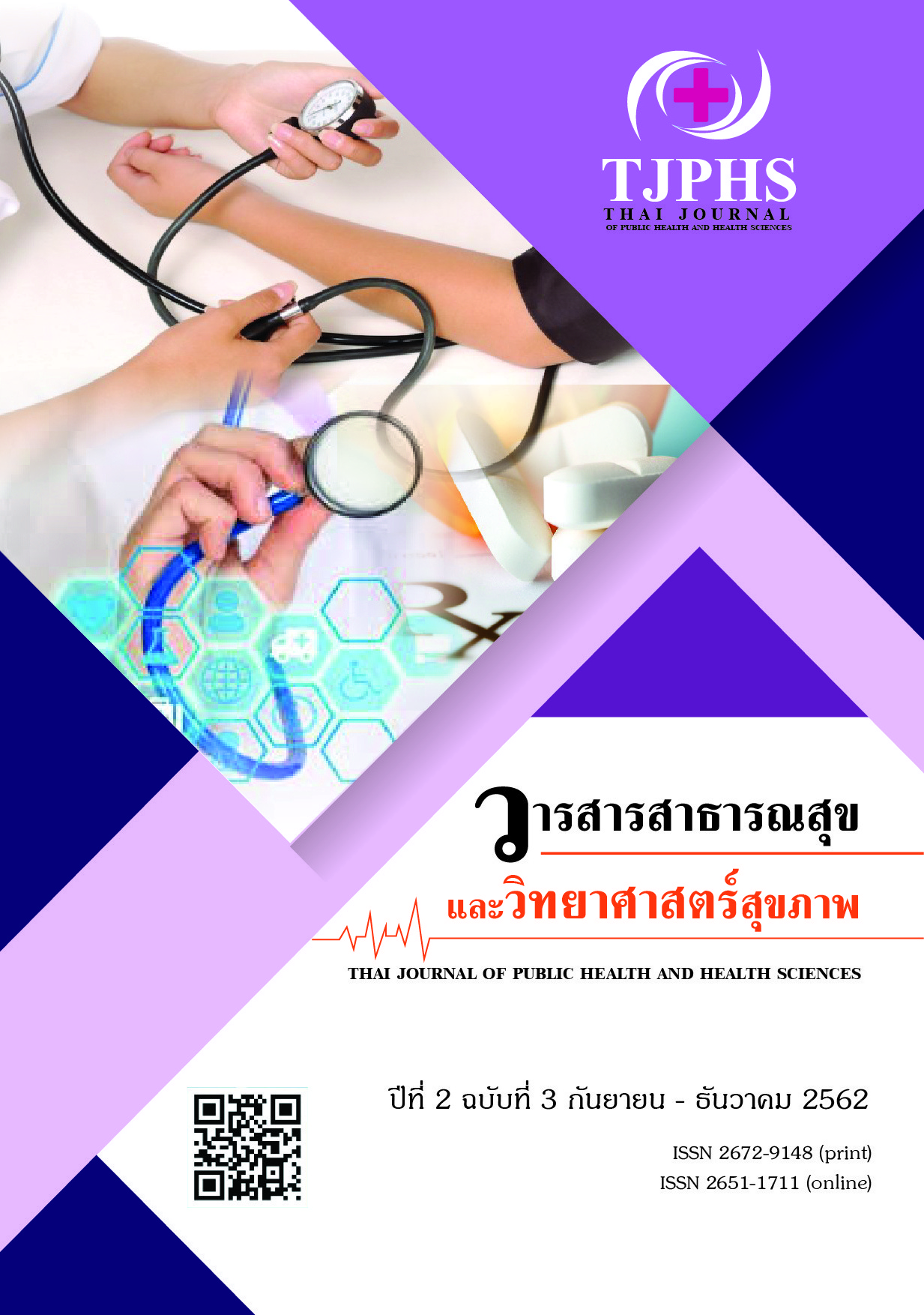ประสิทธิผลของ Social Care Network Model ต่อการดูแลตนเองและบุตร ของมารดาหลังคลอด โรงพยาบาลสิเกา
คำสำคัญ:
เครือข่ายสังคมออนไลน์, ความรู้, พฤติกรรม, การดูแลมารดาและบุตรหลังคลอดบทคัดย่อ
การศึกษานี้มีรูปแบบการวิจัยกึ่งทดลอง มีวัตถุประสงค์เพื่อศึกษาประสิทธิผลของ Social Care Network Model ในการดูแลตนเองและบุตรของมารดาหลังคลอด ในโรงพยาบาลสิเกา จังหวัดตรัง กลุ่มตัวอย่างคือมารดาหลังคลอดที่คลอดโรงพยาบาลสิเกา จำนวน 40 คน โดยแบ่งเป็นกลุ่มทดลอง 20 คน และกลุ่มควบคุม 20 คน โดยวิธีสุ่มอย่างง่าย กลุ่มควบคุมได้รับการดูแลหลังคลอดแบบปกติ ส่วนกลุ่มทดลองได้รับโปรแกรมการดูแลโดยใช้ Social Care Network Model ซึ่งประกอบด้วย 1) บทเรียน “หมอในบ้าน” 2) ห้องเรียนคุณแม่ ผ่านกลุ่ม Line และ Facebook และ 3) การเยี่ยมบ้านหลังคลอด เก็บข้อมูลตั้งแต่เดือนมีนาคม - พฤษภาคม 2560 โดยใช้แบบทดสอบความรู้เรื่องการดูแลตนเองและบุตรของมารดาหลังคลอด แบบประเมินพฤติกรรมการดูแลตนเองและบุตรของมารดาหลังคลอด แบบประเมินภาวะแทรกซ้อนที่เกิดขึ้นกับมารดาและทารกหลังคลอด และแบบประเมินความพึงพอใจของมารดาหลังคลอดต่อ Social Care Network Model วิเคราะห์ข้อมูลโดยใช้สถิติ ร้อยละ ค่าเฉลี่ย ส่วนเบี่ยงเบนมาตรฐาน Paired T-test และ Independent T-test ผลการศึกษา พบว่า ภายในกลุ่มทดลอง คะแนนเฉลี่ยความรู้ในการดูแลตนเองและบุตรของกลุ่มตัวอย่างมารดา ก่อนและหลังการทดลอง มีความแตกต่างกันอย่างมีนัยสำคัญทางสถิติที่ระดับ 0.05 (p-value <0.001) หลังทดลอง กลุ่มทดลองมีคะแนนเฉลี่ยพฤติกรรมการดูแลตนเองและบุตรโดยรวม สูงกว่ากลุ่มควบคุมอย่างมีนัยสำคัญทางสถิติที่ระดับ 0.05 (p-value<0.001) ไม่พบภาวะแทรกซ้อนในกลุ่มทดลอง ระดับความพึงพอใจต่อการใช้สื่อ Social Care Network Model โดยรวมมากที่สุด (4.76 ± 0.34 คะแนน) ข้อค้นพบจากการศึกษาครั้งนี้บ่งบอกถึงประสิทธิผลของโปรแกรมนี้ได้เป็นอย่างดี
เอกสารอ้างอิง
Bloom, B. S. (1968). Learning for Mastery. UCLA Evaluation Comment, 1(2), 1–8.
Leventhal, H., & Johnson, J.E. (1983). Laboratory and field experimentation: Development of a theory of self-regulation. In P.J. Wooldridge, M.H.Schmitt, J.K. Skipper, & R.C. Leonard (Eds.), Behavioral science and nursing theory (pp.189-262). St.Louis: Mosby.
Murray, S.S. and McKinney, E.S. (2014). Pain management during childbirth. In Foundation of Maternal-Newborn and Women’s Health Nursing. 6th ed., (pp.278-282). United States of America :Saunders Elsevier.
Naoko, M., Yaeko, K., Hiromi, E. and Shigeko, H. (2013). Literature review of risk factors and preventive interventions for postpartum hemorrhage. Journal of Japan Academy of Midwifery. 27(1): 4-15.
Pillitteri, A. (2014). Maternal and child health nursing: care of the childbearing and childrearing amily. Philadelphia:Wolters Kluwer Health/Lippincott Williams & Wilkins.
Rakjing, P., Engchuan, W., & Rotrat, W. (2018). Postpartum ward Report 2017.
Sangwarn, M. & Rotjananirunkit, N. (2015). Comparative study on the effectiveness of two teaching medias: Use of video and use of flip chart instructions on the knowledge of postpartum women for postpartum practies and breastfeeding skills. Journal of public health nursing. 29(10): 56 – 66. (in Thai)
Sikao Hospital. (2017). Sikao Annual Report 2017.
Taweang, A. (2011). Effect of videotape on mothers' participation in Venipuncture pain relief of newborns. Master's Thesis, Faculty of Nursing. Khon Khaen University.
ดาวน์โหลด
เผยแพร่แล้ว
รูปแบบการอ้างอิง
ฉบับ
ประเภทบทความ
สัญญาอนุญาต
บทความทุกบทความที่ได้รับการตีพิมพ์ถือเป็นลิขสิทธิ์ของ วารสารสาธารณสุข
















